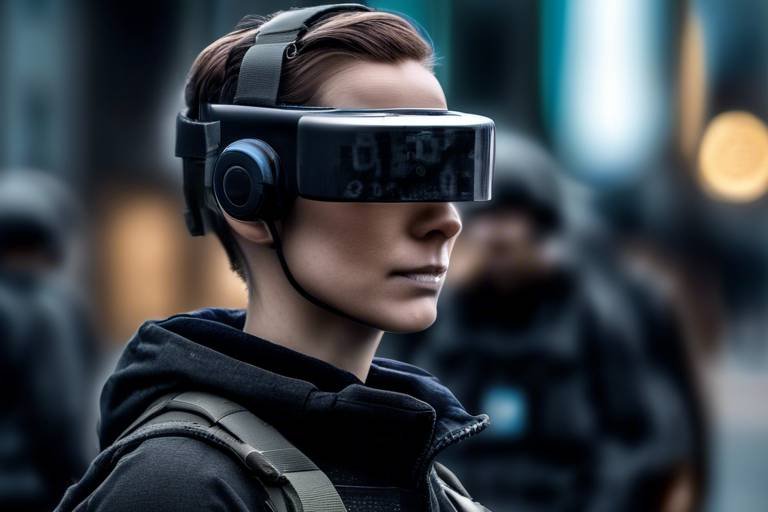Wearable Tech for Tracking Physical Performance in Training
In today’s fast-paced world, where every second counts, the integration of wearable technology into our training regimens has revolutionized how we approach fitness and physical performance. Imagine having a personal coach, a health consultant, and a performance analyst all wrapped around your wrist or snugly fitted on your body. That’s the power of wearable tech! These innovative devices are not just gadgets; they are game-changers that provide real-time insights into our physical activities, helping us optimize our workouts and achieve our fitness goals.
As we dive deeper into the realm of wearable technology, it’s essential to understand what makes these devices so impactful. They offer a treasure trove of data that can be easily accessed and analyzed. Whether you’re a casual gym-goer or a dedicated athlete, the ability to track your performance metrics like heart rate, calories burned, and even sleep quality can pave the way for significant improvements. Think of it as having a detailed map for your fitness journey, guiding you through each step, ensuring you don’t stray off course.
Moreover, the motivation factor cannot be overlooked. Many wearables come equipped with features that encourage users to push their limits, whether it’s through reminders to get moving, challenges to beat personal records, or even sharing achievements with friends. It’s like having a cheering squad right there with you, urging you to go the extra mile. So, if you’ve ever wondered how to elevate your training game, wearable tech might just be the answer you’ve been looking for!
Wearable technology provides numerous advantages, including real-time data tracking, personalized feedback, and enhanced motivation, all contributing to improved training outcomes and performance optimization.
One of the most significant benefits of wearable tech is the real-time data tracking. Imagine you’re in the middle of a grueling workout, and your device is monitoring your heart rate, calorie expenditure, and even your hydration levels. This data not only helps you understand how your body is responding to the workout but also allows you to make immediate adjustments if necessary. For instance, if your heart rate spikes too high, you might decide to take a breather or slow down your pace. This immediate feedback loop can be crucial for maintaining optimal performance.
Additionally, many wearable devices offer personalized feedback. This means that instead of relying on generic advice, you receive tailored recommendations based on your specific performance metrics. It’s like having a personal trainer who knows your body inside and out! This feature can help you identify your strengths and weaknesses, allowing you to focus on areas that need improvement. For example, if your device indicates that you’re not hitting your target heart rate during cardio sessions, you can adjust your intensity accordingly.
Various wearable devices are available, such as fitness trackers, smartwatches, and heart rate monitors, each designed to cater to different aspects of physical performance and training needs.
When it comes to wearable devices, the options are as diverse as the fitness community itself. From sleek fitness trackers that clip onto your waistband to multifunctional smartwatches that double as a fashion statement, there’s something for everyone. Each type of device serves a unique purpose, and choosing the right one can significantly impact your training experience. For instance, if you’re primarily interested in tracking your daily activity levels, a simple fitness tracker might suffice. However, if you’re looking for a more comprehensive solution that includes notifications and app integrations, a smartwatch could be the better choice.
Fitness trackers are popular devices that monitor daily activities, including steps, calories burned, and sleep patterns, helping users maintain an active lifestyle and set achievable fitness goals.
Key features of fitness trackers may include heart rate monitoring, GPS tracking, and smartphone integration, offering users comprehensive insights into their physical performance and health metrics.
Several brands dominate the fitness tracker market, including Fitbit, Garmin, and Xiaomi, each offering unique features and designs to suit various fitness enthusiasts.
Smartwatches combine traditional watch functionalities with advanced fitness tracking capabilities, allowing users to monitor their performance while staying connected to notifications and apps.
Heart rate monitors are essential for athletes and fitness enthusiasts, providing accurate data on heart rate variability, intensity levels, and overall cardiovascular performance during training sessions.
Heart rate monitors come in various forms, including chest straps and wrist-based sensors, each offering different levels of accuracy and comfort for users during workouts.
Selecting the appropriate heart rate monitor depends on individual training goals, comfort preferences, and desired features, ensuring optimal performance tracking during physical activities.
- What is the primary purpose of wearable tech in training? Wearable tech is designed to track physical performance metrics, providing real-time data that helps individuals optimize their training and achieve fitness goals.
- Can wearable devices improve my motivation? Absolutely! Many devices offer features that encourage you to stay active and challenge yourself, making workouts more engaging.
- Which wearable device should I choose? It depends on your specific needs. If you want basic activity tracking, a fitness tracker may be sufficient. For more advanced features, consider a smartwatch.
Benefits of Wearable Tech
When it comes to enhancing your training routine, wearable technology is like having a personal coach strapped to your wrist. These devices provide real-time data tracking that can transform the way you approach your workouts. Imagine being able to see your heart rate, calories burned, and even your pace while you’re on the move. This immediate feedback allows you to make adjustments on the fly, ensuring you’re always pushing your limits without overdoing it. It's like having a crystal ball that shows you exactly how your body is responding to your efforts!
One of the most significant advantages of wearable tech is its ability to deliver personalized feedback. These devices analyze your performance metrics and offer tailored recommendations based on your unique fitness level and goals. For instance, if you’re training for a marathon, your smartwatch might suggest varying your pace or adjusting your hydration intake based on your heart rate trends. This kind of customization helps you stay motivated and engaged, making your fitness journey feel less like a chore and more like an adventure.
Furthermore, the motivational aspect of wearable tech cannot be overstated. Many devices come equipped with features that allow you to set goals and track your progress over time. You can celebrate milestones, whether it’s reaching a certain number of steps in a day or achieving a new personal best in your workouts. This gamification of fitness creates a sense of accomplishment that can keep you coming back for more. Plus, some devices even allow you to connect with friends or join challenges, adding a social element that can boost your motivation. Who doesn't like a little friendly competition?
Another key benefit is the ability to monitor your overall health. Many wearables track not only your physical activity but also your sleep patterns and stress levels. Understanding how these elements interact can be crucial for achieving optimal performance. For example, if you notice that poor sleep is affecting your workout quality, you can take proactive steps to improve your rest. It’s all about creating a holistic picture of your health and fitness, allowing you to make informed decisions.
In summary, the benefits of wearable tech extend far beyond simple tracking. With real-time data, personalized feedback, enhanced motivation, and comprehensive health monitoring, these devices are revolutionizing the way we approach our physical training. They empower users to take control of their fitness journey, making it easier to achieve goals and maintain an active lifestyle. So, why not embrace the future of fitness? Equip yourself with wearable tech and watch your performance soar!
Types of Wearable Devices
In the ever-evolving world of fitness, wearable devices have become essential tools for anyone looking to enhance their training regimen. These devices not only help track physical performance but also provide insights that can lead to improved outcomes. With a plethora of options available, it's crucial to understand the different types of wearable devices and how they can cater to your specific training needs.
At the forefront of this technology are fitness trackers, which have gained immense popularity among fitness enthusiasts. They are designed to monitor daily activities, such as steps taken, calories burned, and even sleep quality. Imagine having a personal coach on your wrist, nudging you to get up and move when you've been stationary for too long! Fitness trackers serve as a constant reminder to stay active and can even help you set realistic fitness goals.
Next up are smartwatches. These devices take the functionality of fitness trackers a step further by integrating traditional watch features with advanced fitness monitoring capabilities. They allow users to receive notifications, check messages, and interact with apps, all while keeping an eye on their physical performance. It’s like having a mini smartphone on your wrist that also tracks your heart rate and workout intensity. With smartwatches, you can enjoy the best of both worlds—staying connected while focusing on your fitness journey.
Another essential wearable device is the heart rate monitor. For athletes and serious fitness buffs, understanding heart rate variability and intensity levels is crucial for optimizing training. Heart rate monitors provide real-time feedback on your cardiovascular performance, helping you gauge whether you're in the right training zone. This data is invaluable for tailoring workouts to meet specific fitness goals, whether you're aiming for endurance, fat loss, or muscle gain.
To give you a clearer picture of the various wearable devices, here’s a quick comparison:
| Device Type | Main Features | Best For |
|---|---|---|
| Fitness Trackers | Step counting, calorie tracking, sleep monitoring | General fitness enthusiasts |
| Smartwatches | Notifications, app integration, fitness tracking | Tech-savvy users who want multifunctionality |
| Heart Rate Monitors | Real-time heart rate data, training zone tracking | Athletes and serious trainers |
In conclusion, the variety of wearable devices available today means that there’s something for everyone, regardless of your fitness level or training goals. Whether you prefer the simplicity of a fitness tracker, the multifunctionality of a smartwatch, or the precision of a heart rate monitor, these devices are designed to help you stay on track and motivated. So, which one will you choose to accompany you on your fitness journey?
As you dive into the world of wearable technology, you might have some questions. Here are a few frequently asked questions that can help you make informed decisions:
- What is the main purpose of wearable devices? Wearable devices track and monitor various physical activities and health metrics to enhance performance and promote fitness.
- Do I need a smartwatch if I already have a fitness tracker? It depends on your needs. Smartwatches offer additional functionalities like notifications and app integration, while fitness trackers focus primarily on activity tracking.
- Can heart rate monitors help with weight loss? Yes, by providing insights into your heart rate zones, you can optimize your workouts for fat burning and overall fitness.
Fitness Trackers
Fitness trackers have rapidly become the go-to gadget for anyone serious about their health and wellness. These nifty devices are not just glorified pedometers; they are sophisticated pieces of technology that provide a wealth of information about your daily activities and overall fitness levels. Imagine having a personal trainer right on your wrist, constantly monitoring your movements and pushing you to achieve your goals! Whether you’re a casual walker or a dedicated athlete, fitness trackers can help you stay motivated and informed.
One of the biggest advantages of fitness trackers is their ability to monitor daily activities in real-time. They typically track metrics such as steps taken, calories burned, and even your sleep patterns. This data can be incredibly empowering, as it allows you to see how your daily habits contribute to your overall health. For instance, if you find out you’re consistently falling short of your step goal, you might be inspired to take more walks during your lunch break or choose the stairs instead of the elevator. The insights provided by these devices can lead to small, manageable changes that yield significant results over time.
Moreover, many fitness trackers come equipped with features that allow you to set personalized fitness goals. This means you can tailor your objectives based on your specific needs and lifestyle. Want to run a 5K? Your tracker can help you create a training plan by gradually increasing your step count and distance over time. Interested in losing weight? You can set a calorie-burning goal and track your progress towards that target. The flexibility of these devices makes them suitable for a wide range of fitness enthusiasts, regardless of their current fitness level.
In addition to tracking activities, many fitness trackers offer advanced features like heart rate monitoring, GPS tracking, and smartphone integration. Heart rate monitoring, for example, can help you gauge the intensity of your workouts. This is particularly useful for those engaging in high-intensity interval training (HIIT) or other strenuous activities where understanding your heart rate zones can optimize performance. GPS tracking is essential for runners and cyclists, as it allows you to map your routes and analyze your speed and distance. Furthermore, smartphone integration means you can receive notifications, calls, and messages right on your wrist, ensuring you stay connected while focusing on your fitness.
With so many options on the market, choosing the right fitness tracker can feel overwhelming. However, it’s important to consider what features matter most to you. Some popular brands that dominate the fitness tracker scene include:
- Fitbit - Known for its user-friendly interface and robust health tracking capabilities.
- Garmin - Ideal for serious athletes, offering advanced metrics and GPS functionality.
- Xiaomi - Offers budget-friendly options without compromising essential features.
In conclusion, fitness trackers are an excellent investment for anyone looking to enhance their physical performance and maintain an active lifestyle. By providing real-time data and personalized feedback, these devices not only help you track your progress but also keep you motivated. So, if you’re ready to take your fitness journey to the next level, consider adding a fitness tracker to your arsenal!
Features of Fitness Trackers
Fitness trackers have revolutionized the way we approach health and wellness by offering a plethora of features designed to keep us informed and motivated. One of the standout features is heart rate monitoring, which allows users to keep a close eye on their cardiovascular health. By tracking your heart rate in real-time, you can ensure that you're exercising within your target zones, maximizing efficiency, and minimizing the risk of overexertion. Imagine being able to adjust your workout intensity on the fly, all thanks to the data your device provides!
Another fantastic feature is GPS tracking. For those who love outdoor activities like running or cycling, GPS functionality means you can accurately track your routes, distances, and speeds. This not only helps in setting and achieving personal records but also adds an element of adventure to your workouts. Think of it as having a personal coach guiding you through your favorite trails, providing insights on how to improve with each session.
Fitness trackers also excel in sleep tracking. Understanding your sleep patterns can be crucial for recovery and overall health. By monitoring your sleep cycles, these devices can provide insights into how well you rest and suggest improvements. It's like having a sleep consultant on your wrist, nudging you toward better habits. And let’s not forget about smartphone integration. Most fitness trackers sync seamlessly with your smartphone, allowing you to receive notifications, calls, and messages without interrupting your workout. This feature ensures that you stay connected while you sweat, making it easier to balance your fitness journey with your daily life.
To summarize, here are some key features that make fitness trackers essential for anyone serious about their health:
- Heart Rate Monitoring: Real-time tracking for optimal exercise intensity.
- GPS Tracking: Accurate route and distance measurements for outdoor activities.
- Sleep Tracking: Insights into sleep quality and patterns for better recovery.
- Smartphone Integration: Stay connected with notifications while working out.
With these features, fitness trackers not only help you monitor your performance but also motivate you to push your limits. They are like having a fitness buddy who is always there to cheer you on, offering insights and encouragement every step of the way. So, if you're looking to elevate your training game, investing in a quality fitness tracker might just be the game-changer you need!
Q: How accurate are fitness trackers?
A: Fitness trackers generally offer good accuracy for basic metrics like steps and heart rate, but their precision can vary based on the device and the specific activity being tracked.
Q: Can I wear a fitness tracker while swimming?
A: Many modern fitness trackers are water-resistant and can be worn while swimming. However, it's essential to check the specifications of your device for its water resistance rating.
Q: Do I need a smartphone to use a fitness tracker?
A: While many fitness trackers benefit from smartphone integration for enhanced features and data analysis, some models can operate independently and store data internally.
Q: How do I choose the right fitness tracker for me?
A: Consider your fitness goals, preferred activities, and desired features. Research different models and read user reviews to find a tracker that suits your lifestyle best.
Popular Fitness Tracker Brands
When it comes to fitness trackers, the market is flooded with options, making it a bit overwhelming for anyone looking to choose the right one. However, a few brands have established themselves as leaders in the industry, offering devices that not only track your activity but also motivate you to reach your fitness goals. Let’s dive into some of the most popular fitness tracker brands that have won the hearts of fitness enthusiasts worldwide.
Fitbit is often the first name that comes to mind when discussing fitness trackers. Known for their user-friendly interface and sleek designs, Fitbit devices offer a range of features such as heart rate monitoring, sleep tracking, and even guided breathing exercises. Their app is intuitive, making it easy for users to track their progress and stay motivated. Whether you're a casual walker or a serious runner, Fitbit has something to cater to your needs.
Next up is Garmin, a brand synonymous with performance and precision. Garmin fitness trackers are particularly popular among athletes and outdoor enthusiasts due to their advanced GPS capabilities and robust build quality. These devices are designed to withstand the rigors of intense training and provide detailed analytics that can help in optimizing your performance. From running and cycling to swimming, Garmin covers it all.
Another brand making waves in the fitness tracker scene is Xiaomi. Offering some of the most affordable options without compromising on quality, Xiaomi's Mi Band series has gained a loyal following. With features like heart rate monitoring, sleep tracking, and even notifications from your smartphone, these trackers provide excellent value for money, making fitness accessible to a broader audience.
These brands are just the tip of the iceberg, with many others like Apple, Samsung, and Polar also offering innovative fitness trackers that cater to various user needs and preferences. Each brand has its unique features and strengths, so it’s essential to consider what you value most in a fitness tracker. Whether it's advanced metrics, battery life, or design, there's a perfect fit for everyone.
In conclusion, choosing the right fitness tracker can greatly enhance your training experience. By investing in a reputable brand, you not only gain access to reliable tracking but also a community of users who share tips and motivation. So, which brand will you choose to accompany you on your fitness journey?
- What features should I look for in a fitness tracker? When choosing a fitness tracker, consider features such as heart rate monitoring, GPS tracking, sleep analysis, and smartphone notifications.
- Are fitness trackers accurate? Most fitness trackers are quite accurate for general activity tracking, but for specific metrics like heart rate, some devices may perform better than others.
- Can I use a fitness tracker without a smartphone? Many fitness trackers can function independently, but syncing with a smartphone usually enhances the experience by providing detailed insights and data analysis.
- How do I choose the best fitness tracker for my needs? Assess your fitness goals, preferred activities, and budget to find a tracker that aligns with your lifestyle and provides the features you need.
Smartwatches
Smartwatches have revolutionized the way we approach fitness and training. These devices are not just timepieces; they are powerful tools that combine traditional watch functionalities with advanced fitness tracking capabilities. Imagine having a personal trainer on your wrist, guiding you through workouts while keeping you connected to your digital life. That's the magic of smartwatches!
One of the standout features of smartwatches is their ability to monitor a wide range of health metrics. They typically come equipped with sensors that track heart rate, monitor sleep quality, and even measure blood oxygen levels. This data can be invaluable for anyone looking to optimize their training. For instance, if you're pushing yourself during a workout, your smartwatch can alert you when your heart rate exceeds a safe threshold, helping you avoid overexertion.
Moreover, smartwatches often integrate seamlessly with your smartphone, allowing you to receive notifications for calls, messages, and app alerts without having to pull out your phone. This feature is particularly useful during workouts when you want to stay focused but still remain reachable. You can even control your music playlist directly from your wrist, making it easier to keep the beats flowing as you sweat it out.
Another aspect that makes smartwatches appealing is their versatility. They cater to various fitness levels and activities, whether you're a casual walker or a hardcore marathon runner. Many models come with built-in GPS, which means you can track your runs or rides without needing to carry your phone. This feature not only enhances convenience but also allows for more accurate tracking of your outdoor activities.
When it comes to choosing a smartwatch, there are numerous options available on the market. Some popular brands include:
- Apple Watch: Known for its sleek design and robust app ecosystem.
- Garmin: Favored by serious athletes for its advanced tracking features.
- Samsung Galaxy Watch: Offers a great balance between functionality and style.
Ultimately, the right smartwatch for you will depend on your specific needs and preferences. Whether you prioritize fitness tracking, app integration, or aesthetics, there's likely a smartwatch out there that fits your lifestyle perfectly. As you embark on your fitness journey, consider investing in a smartwatch that not only tracks your progress but also motivates you to push your limits.
Heart Rate Monitors
Heart rate monitors have become essential tools for both athletes and fitness enthusiasts alike, providing critical insights into cardiovascular performance during training sessions. Imagine gearing up for a workout, and instead of just guessing how hard you're pushing yourself, you have real-time data right on your wrist or chest. This data can be a game changer, helping you to fine-tune your training regimen and push your limits safely and effectively.
These devices track your heart rate variability, which is crucial for understanding how your body responds to different levels of exertion. Whether you're sprinting on a track, lifting weights, or practicing yoga, knowing your heart rate can help you gauge your intensity levels. For instance, if you're aiming to improve your endurance, maintaining a steady heart rate within a specific zone can be vital. Conversely, if you're looking to build strength, knowing when to push harder or when to take a breather can make all the difference.
Heart rate monitors come in various forms, each with unique benefits and functionalities. The two main types are chest straps and wrist-based sensors. Chest straps tend to offer more accurate readings, especially during high-intensity workouts, as they are positioned closer to the heart. On the other hand, wrist-based sensors, like those found in smartwatches, provide convenience and ease of use but may sometimes lag in accuracy during intense activities.
When selecting a heart rate monitor, consider your individual training goals. Are you a casual runner looking to track your heart rate during jogs, or are you a serious athlete preparing for competitions? Your choice can significantly affect your performance tracking. Additionally, comfort is key; a monitor that feels good during workouts will encourage you to use it consistently. Some monitors come with features like Bluetooth connectivity to sync with your smartphone or fitness apps, enhancing your ability to analyze your performance over time.
| Type of Monitor | Accuracy | Comfort | Best For |
|---|---|---|---|
| Chest Strap | High | Moderate | Athletes, High-Intensity Training |
| Wrist-Based Sensor | Moderate | High | Casual Users, Daily Fitness Tracking |
Ultimately, heart rate monitors are more than just gadgets; they are powerful allies in your fitness journey. By providing accurate data, they help you make informed decisions about your workouts, ensuring that you can maximize your efforts while minimizing the risk of overtraining or injury. So, whether you're a newbie just starting out or a seasoned pro, integrating a heart rate monitor into your routine can elevate your training experience.
1. How do heart rate monitors work?
Heart rate monitors typically use sensors to detect your heart's electrical signals. Chest straps usually use electrodes to measure these signals, while wrist-based monitors use optical sensors to detect blood flow.
2. Can I wear a heart rate monitor all day?
Yes, many heart rate monitors are designed for continuous wear, allowing you to track your heart rate throughout the day and during various activities.
3. Are heart rate monitors waterproof?
Many modern heart rate monitors are water-resistant or waterproof, but it's essential to check the specifications of your device to ensure it meets your needs.
4. How do I choose the right heart rate monitor?
Consider your fitness goals, comfort preferences, and the type of activities you'll be doing. Research different models and read reviews to find the best fit for you.
Types of Heart Rate Monitors
When it comes to tracking your heart rate during workouts, the choice of monitor can make a significant difference in the accuracy and comfort of your training sessions. There are primarily two types of heart rate monitors available on the market: chest straps and wrist-based sensors. Each type has its own set of advantages and potential drawbacks that cater to different preferences and training styles.
Chest straps are often regarded as the gold standard for heart rate monitoring. They typically consist of a strap worn around the chest that houses a sensor, which detects the electrical signals produced by your heart. This type of monitor is known for its high accuracy, making it a favorite among serious athletes and those engaged in high-intensity training. The data collected is usually transmitted to a smartwatch or a fitness app in real-time, allowing for immediate feedback. However, some users find chest straps to be less comfortable, especially during prolonged workouts.
On the other hand, wrist-based sensors have surged in popularity due to their convenience and ease of use. These monitors are integrated into fitness trackers and smartwatches, making them accessible for everyday users who want to keep an eye on their heart rate without the hassle of additional equipment. While wrist-based sensors offer decent accuracy for general fitness tracking, they may not be as precise as chest straps, particularly during intense physical activities. Nonetheless, their comfort and multi-functionality make them an attractive option for casual exercisers.
To help you understand the differences better, here’s a quick comparison:
| Type | Accuracy | Comfort | Use Case |
|---|---|---|---|
| Chest Straps | High | Moderate | High-intensity training, professional athletes |
| Wrist-based Sensors | Moderate | High | Casual workouts, daily activity tracking |
Ultimately, the choice between a chest strap and a wrist-based sensor comes down to your personal training goals and comfort preferences. If you’re focused on achieving peak performance and need precise data, a chest strap might be the way to go. Conversely, if you’re looking for convenience and the ability to track various fitness metrics in one device, a wrist-based sensor could be your best bet. Remember, the right heart rate monitor can enhance your training experience significantly, helping you achieve your fitness goals more effectively.
- What is the best heart rate monitor for beginners? For beginners, wrist-based sensors are often the best choice due to their ease of use and comfort.
- Can heart rate monitors be used for other activities besides running? Absolutely! Heart rate monitors can be beneficial for a variety of activities including cycling, swimming, and weight training.
- How accurate are wrist-based heart rate monitors? While they offer convenience, wrist-based monitors may not be as accurate as chest straps, especially during high-intensity workouts.
Choosing the Right Monitor
When it comes to selecting the right heart rate monitor, the choices can feel overwhelming. With so many options available, how do you decide which one is best for you? First, consider your training goals. Are you an athlete looking to optimize your performance, or a casual gym-goer wanting to keep tabs on your heart rate? Understanding your needs is crucial in narrowing down your options.
Next, think about comfort and usability. Some monitors come in the form of chest straps, which can provide highly accurate readings but may not be the most comfortable for everyone. Others are wrist-based sensors that offer convenience but might sacrifice a bit of accuracy. It’s essential to try different types to see which one feels best during your workouts. Remember, a device that you find uncomfortable is less likely to be worn consistently, which defeats the purpose of tracking your progress.
Another important factor is the features you want in your heart rate monitor. Some devices offer advanced metrics like heart rate variability, recovery time, and even stress levels, while others might focus solely on basic heart rate tracking. If you’re someone who enjoys diving deep into data analysis, you might want a monitor that syncs with your smartphone or other fitness apps to give you a comprehensive overview of your performance. Here's a quick comparison of some common features:
| Feature | Chest Strap | Wrist-based Sensor |
|---|---|---|
| Accuracy | High | Moderate |
| Comfort | Variable | High |
| Data Sync | Often available | Usually available |
| Price Range | Moderate to High | Low to Moderate |
Finally, consider your budget. Heart rate monitors can range from affordable to quite pricey, depending on the brand and features. It's wise to set a budget before you start shopping, but remember that sometimes investing a little more can lead to better accuracy and functionality. Look for customer reviews and ratings to ensure you're getting a quality product that meets your needs.
In summary, choosing the right heart rate monitor requires careful consideration of your training goals, comfort preferences, desired features, and budget. Take the time to research and even try out various models to find the perfect fit for your fitness journey. After all, the right monitor can be a game-changer, helping you achieve your goals and track your progress effectively.
- What is the most accurate type of heart rate monitor? Chest strap monitors are generally considered the most accurate, especially for high-intensity workouts.
- Can I wear a heart rate monitor all day? Yes, many wrist-based monitors are designed for all-day wear and can track your heart rate continuously.
- Do I need a smartphone to use a heart rate monitor? While many devices offer smartphone connectivity for enhanced tracking, it's not always necessary for basic functionality.
- How do I know if my heart rate monitor is working properly? Regularly check the readings against your pulse to ensure accuracy. If you notice discrepancies, it may need recalibration or replacement.
Frequently Asked Questions
- What is wearable technology?
Wearable technology refers to electronic devices that can be worn on the body, often used to track various health and fitness metrics. These gadgets, like fitness trackers and smartwatches, help you monitor your physical performance and overall well-being.
- How can wearable tech improve my training?
Wearable tech enhances your training by providing real-time data, personalized feedback, and motivation. Imagine having a coach on your wrist, guiding you through every step, helping you optimize your workouts, and pushing you to achieve your fitness goals!
- What types of wearable devices are available?
There are various types of wearable devices, including fitness trackers, smartwatches, and heart rate monitors. Each serves a unique purpose: fitness trackers monitor daily activities, smartwatches keep you connected while tracking workouts, and heart rate monitors focus on your cardiovascular performance.
- What features should I look for in a fitness tracker?
When choosing a fitness tracker, consider features like heart rate monitoring, GPS tracking, smartphone integration, and sleep tracking. These functionalities provide a comprehensive overview of your health and help you stay on top of your fitness journey.
- Which brands are the best for fitness trackers?
Some of the top brands in the fitness tracker market include Fitbit, Garmin, and Xiaomi. Each brand offers unique features and designs, catering to different preferences and fitness levels, so you can find the perfect fit for your lifestyle!
- What’s the difference between a smartwatch and a fitness tracker?
While both devices track fitness metrics, smartwatches offer additional functionalities such as notifications, apps, and customizable watch faces. If you want a device that keeps you connected while monitoring your performance, a smartwatch might be the way to go!
- Why are heart rate monitors important?
Heart rate monitors are crucial for athletes and fitness enthusiasts as they provide accurate data on heart rate variability and intensity levels. This information helps you understand your cardiovascular performance and tailor your training to meet your fitness goals effectively.
- What types of heart rate monitors are there?
Heart rate monitors come in various forms, including chest straps and wrist-based sensors. Chest straps generally offer greater accuracy, while wrist-based sensors provide comfort and convenience during workouts.
- How do I choose the right heart rate monitor?
Selecting the right heart rate monitor depends on your training goals, comfort preferences, and desired features. Think about how you plan to use it and what metrics are most important for your fitness journey.


















